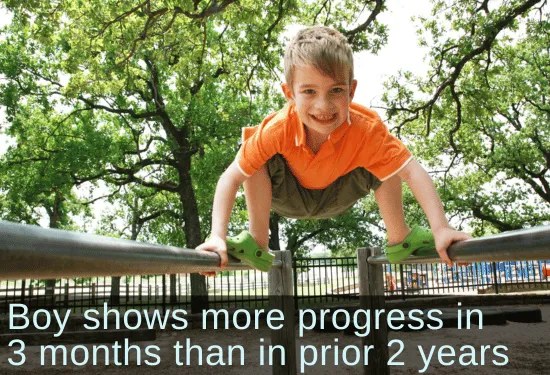Neurodevelopmental movements help with gross motor function and attention
This young boy had a wide variety of motor challenges, including balance and coordination deficits. His occupational therapist began using rhythmic movements and reflex integration, and in just 3 months saw great improvements in his gross motor abilities and attention.
Submitted by Kelly Jaworski, MOT, OTR/L

| Before | After |
|---|---|
| Attention challenges; difficulty following directional/movement instructions | Significantly improved sustained attention to tasks |
| Gross motor challenges | Improved balance, motor planning, and coordination |
Lincoln is a 4 year, 9-month-old male diagnosed with specific developmental disorder of motor function. This client was chosen for this case study due to significant difficulties observed regarding balance and coordination, stiff jerky movements, toe walking, difficulty navigating stairs, speech and auditory processing delays, and difficulty following directional/movement instructions. Poor endurance, frequent fatigue, W-sitting, and decreased core strength are also noted in this client. It should also be noted that this client was born 12 weeks premature. Lincoln’s goals include improving motor planning and coordination, core strength, sensory processing, attention, and fine motor skills, such as cutting, pre-writing, and tracing his name. Based on the challenges listed above, it was determined that Lincoln would benefit from rhythmic movements and the integration of his TLR [Tonic Labyrinthine Reflex]. This client responded well to the rhythmic movements [from the Brain and Sensory Foundations course] and was able to tolerate increases in duration very well when introduced gradually. However, we did encounter challenges when attempting to complete isometric movements. Lincoln initially had difficulty with assuming and maintaining the necessary position to complete the isometric movements. He also has difficulty understanding how to complete movements at 10% strength. In order to resolve this issue, we focused on rhythmic movements and functional play movements [from the Brain and Sensory Foundations course] for 3-4 sessions before resuming isometric movements. Lincoln also demonstrated some difficulty with coordination when completing certain functional play movements.
Although he continues to require cues to maintain the correct position and level of strength, Lincoln demonstrates significantly improved understanding of how to appropriately participate in isometric activities. Lincoln has been participating in rhythmic movements and TLR stimulation/integration 2x/week for 3 months, in addition to at least 1x/week at home with his mother.
Lincoln demonstrates significantly improved sustained attention to tasks, especially directly after completing rhythmic movements and TLR exercises. He also demonstrates significantly improved balance, motor planning, and coordination. Lincoln used to require moderate support to navigate the balance beam, with frequent missteps throughout. He is now able to walk across the balance beam without support and only 1-2 missteps. Lincoln also demonstrates improved confidence and coordination when navigating obstacle courses including climbing ladders and stepping stones. My experience with this client taught me how to be creative in adapting activities to fit the specific needs of the child while they are learning how to participate in functional and isometric activities. It also showed me just how effective integrating the reflexes can be. I was able to see more progress in certain areas after 3 months of reflex integration than in the 2 years I had been working with him prior to implementing these strategies!
(Edited, emphasis added)

